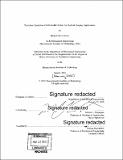| dc.contributor.advisor | Martin L. Culpepper. | en_US |
| dc.contributor.author | Dias Carlson, Rachel (Rachel A.) | en_US |
| dc.contributor.other | Massachusetts Institute of Technology. Department of Mechanical Engineering. | en_US |
| dc.date.accessioned | 2016-07-01T18:42:41Z | |
| dc.date.available | 2016-07-01T18:42:41Z | |
| dc.date.copyright | 2016 | en_US |
| dc.date.issued | 2016 | en_US |
| dc.identifier.uri | http://hdl.handle.net/1721.1/103465 | |
| dc.description | Thesis: S.M., Massachusetts Institute of Technology, Department of Mechanical Engineering, 2016. | en_US |
| dc.description | Cataloged from PDF version of thesis. | en_US |
| dc.description | Includes bibliographical references (pages 102-104). | en_US |
| dc.description.abstract | The purpose of this work is to learn how the performance of a constraint system that interfaces with nonlinear elastic materials such as biological tissue can be predicted by a model. The direct application of this work is the determination of the feasibility of restraining awake and anesthetized mice skulls to submicron levels of movement for biological imaging applications without direct attachment to the skull. A device capable of restricting mouse skull movement to less than a micron in every direction without requiring the rigid attachment of a fixture to the skull would enable studies of bone marrow activity that are not currently possible. No existing work has attempted to determine the performance limits of a constraint system interfacing with nonlinear elastic material. This thesis introduces a model for determining the constraint system performance, and demonstrates how material properties may be tested to determine their relative significance and inclusion in the system model. The theoretical model is applied to the case of an awake mouse to demonstrate that a tissue-interfacing constraint system can only limit movement to hundreds of microns and is not capable of achieving the desired submicron level performance. For the case of an anesthetized mouse, the designed device is tested and achieves the desired sub-micron performance in all three axes for improved imaging capabilities in anesthetized mice. | en_US |
| dc.description.statementofresponsibility | by Rachel Dias Carlson. | en_US |
| dc.format.extent | 105 pages | en_US |
| dc.language.iso | eng | en_US |
| dc.publisher | Massachusetts Institute of Technology | en_US |
| dc.rights | M.I.T. theses are protected by copyright. They may be viewed from this source for any purpose, but reproduction or distribution in any format is prohibited without written permission. See provided URL for inquiries about permission. | en_US |
| dc.rights.uri | http://dspace.mit.edu/handle/1721.1/7582 | en_US |
| dc.subject | Mechanical Engineering. | en_US |
| dc.title | Precision constraint of deformable bodies for medical imaging applications | en_US |
| dc.type | Thesis | en_US |
| dc.description.degree | S.M. | en_US |
| dc.contributor.department | Massachusetts Institute of Technology. Department of Mechanical Engineering | |
| dc.identifier.oclc | 952320500 | en_US |
